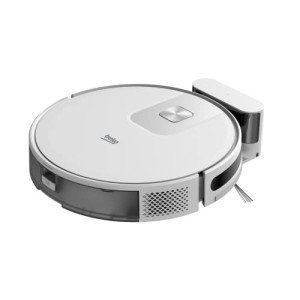The Rise of Robotic Vacuums: A Comprehensive Guide
In the busy world of technological improvements, the integration of robotics into daily family tasks has actually revolutionized the way individuals maintain their homes. Among the most popular and useful innovations is the robotic vacuum cleaner, a device designed to autonomously tidy floors, minimizing the requirement for manual labor. This article digs into the evolution, performance, advantages, and future of robotic vacuums, providing a detailed guide for those considering including one to their family.
The Evolution of Robotic Vacuums
The concept of a robotic vacuum go back to the late 20th century, but it wasn't until the early 2000s that these gadgets ended up being commercially viable. The first widely recognized robotic vacuum, the iRobot Roomba, was presented in 2002. Considering that then, the innovation has advanced significantly, with modern-day models including advanced navigation systems, effective suction, and smart home combination.
Key Milestones:
- 2002: Introduction of the iRobot Roomba - The very first commercially successful robotic vacuum.
- 2005: Advanced Navigation - Integration of infrared sensors and cliff detection to avoid falls.
- 2010: Wi-Fi Connectivity - Allowing remote control and scheduling via mobile phone apps.
- 2015: Mapping and Zoning - Advanced mapping innovation for more effective cleaning.
- 2020: AI and Machine Learning - Enhanced navigation and cleaning patterns through synthetic intelligence.
How Robotic Vacuums Work
Robotic vacuums run utilizing a combination of sensors, algorithms, and motors. Here's a breakdown of the essential elements and processes:
- Sensors: These consist of infrared, ultrasonic, and optical sensors that help the vacuum identify barriers, edges, and dirt. Some designs also utilize cams for visual mapping.
- Mapping and Navigation: Advanced designs use SLAM (Simultaneous Localization and Mapping) innovation to develop a map of the cleaning area and navigate efficiently.
- Suction and Brushes: Robotic vacuums utilize effective motors to produce suction and various brushes to select up dirt and debris. Some models include side brushes to reach into corners.
- Battery and Charging: Most robotic vacuums are geared up with rechargeable lithium-ion batteries. They go back to their charging dock when the battery is low.
- Smart Home Integration: Many designs can be managed through smartphone apps, voice assistants like Amazon Alexa or Google Assistant, and can be integrated into smart home systems.
Benefits of Robotic Vacuums
- Convenience: One of the most considerable benefits is the convenience of hands-free cleaning. Users can arrange cleanings or start them remotely, permitting a tidy home without the effort.
- Efficiency: Modern robotic vacuums are designed to tidy effectively, covering big locations and navigating around barriers with ease.
- Long-Term Savings: While the initial expense might be higher, the long-lasting savings on manual cleaning tools and the time saved can be significant.
- Allergic reaction Relief: Regular cleaning can assist decrease irritants in the home, making it a beneficial investment for allergic reaction sufferers.
- Eco-Friendly: Many models are energy-efficient and utilize recyclable materials, making them a more sustainable cleaning choice.
Popular Models and Features
iRobot Roomba i7+
- Features: Advanced mapping, automatic dirt disposal, Wi-Fi connectivity, and voice control.
- Cost Range: ₤ 600 - ₤ 1,000
Dyson 360 Heurist
- Features: 360-degree video camera for mapping, powerful suction, and HEPA purification.
- Cost Range: ₤ 600 - ₤ 800
Ecovacs Deebot Ozmo T8
- Features: TrueMapping navigation, mopping abilities, and voice control.
- Cost Range: ₤ 500 - ₤ 700
Neato D7
- Features: Laser navigation, big cleaning area, and app control.
- Cost Range: ₤ 500 - ₤ 700
Future Trends in Robotic Vacuums
The future of robotic vacuums is appealing, with ongoing improvements in technology. Some patterns to expect consist of:
- Enhanced AI and Machine Learning: More advanced algorithms will make it possible for much better navigation, obstacle avoidance, and cleaning efficiency.
- Integration with Smart Home Ecosystems: Increased compatibility with various smart home gadgets and platforms.
- Enhanced Battery Life: Longer-lasting batteries to cover bigger locations without requiring to charge.
- Multi-Functionality: Beyond vacuuming, future designs may consist of extra features like air purification and surface area cleaning.
FAQs
Q: Are robotic vacuums as effective as traditional vacuums?A: While they might not be as powerful as high-end traditional vacuums, modern-day robotic vacuums are extremely reliable for regular cleaning tasks. They are particularly helpful for maintaining a tidy home in between deep cleans up.
Q: How frequently should I clean the filters and brushes?A: It is suggested to clean up the filters and brushes after every couple of uses to ensure optimal efficiency. Consult the user handbook for particular upkeep instructions.
Q: Can robotic vacuums browse stairs?A: Most robotic vacuums are equipped with cliff sensing units that prevent them from falling down stairs. Nevertheless, they are not designed to tidy stairs.
Q: Are robotic vacuums loud?A: Generally, robotic vacuums are quieter than traditional vacuums. However, Robot Vacuum Mops can vary by design. Some models use quiet cleaning modes for nighttime usage.
Q: Can I use a robotic vacuum with animals?A: Yes, lots of robotic vacuums are created to manage pet hair and dander. Search for models with strong suction and specialized pet cleaning functions.
Robotic vacuums have come a long way since their beginning, using a hassle-free, effective, and environment-friendly option to household cleaning. With continuous developments in innovation, these gadgets are ending up being more sophisticated and easy to use. Whether you're wanting to save time, lower allergens, or just delight in a cleaner home, a robotic vacuum is a beneficial investment. By understanding the functions, advantages, and future patterns, you can make a notified choice to enhance your home cleaning experience.

